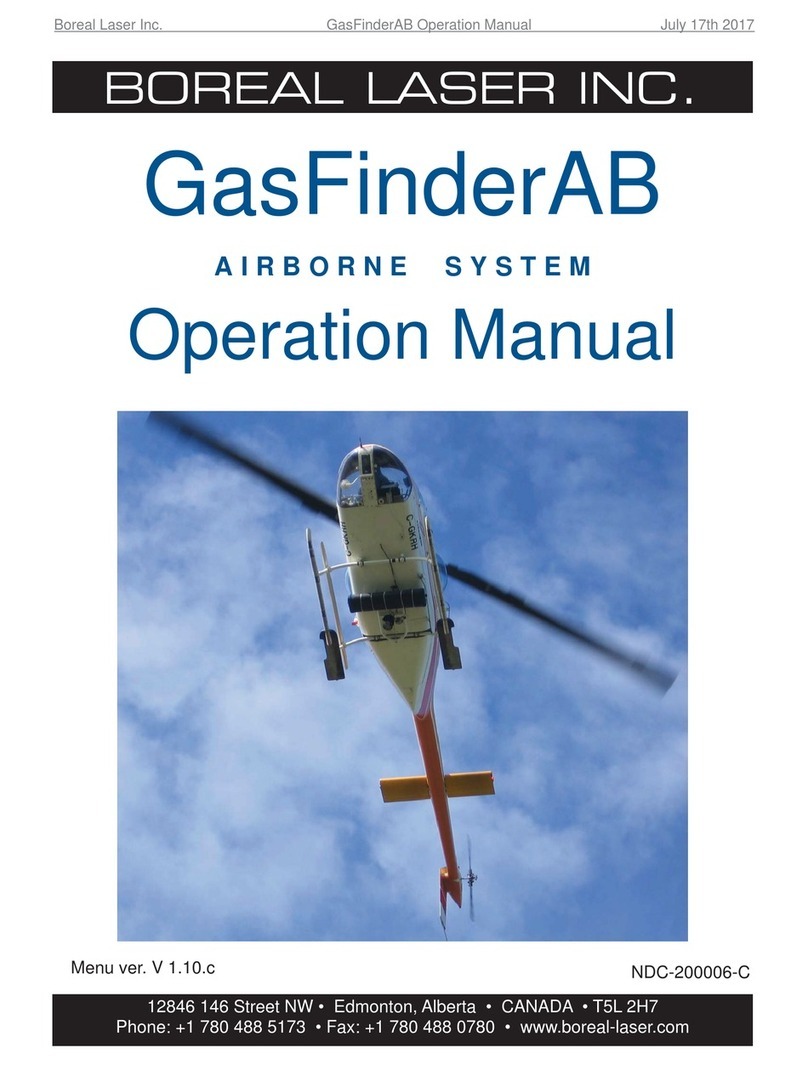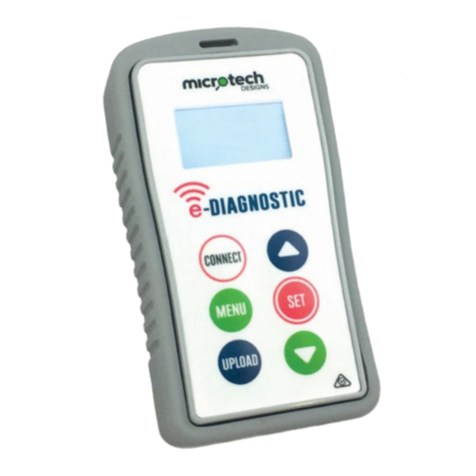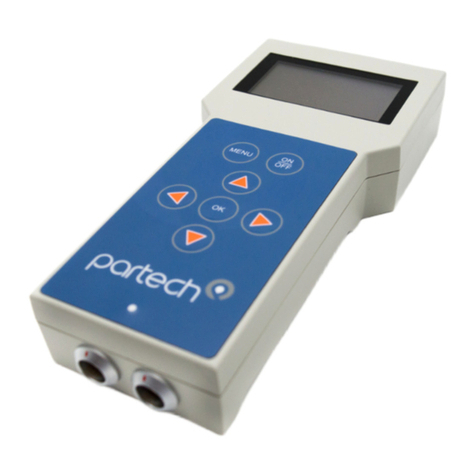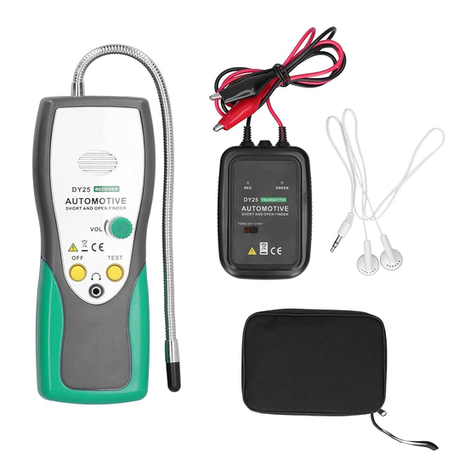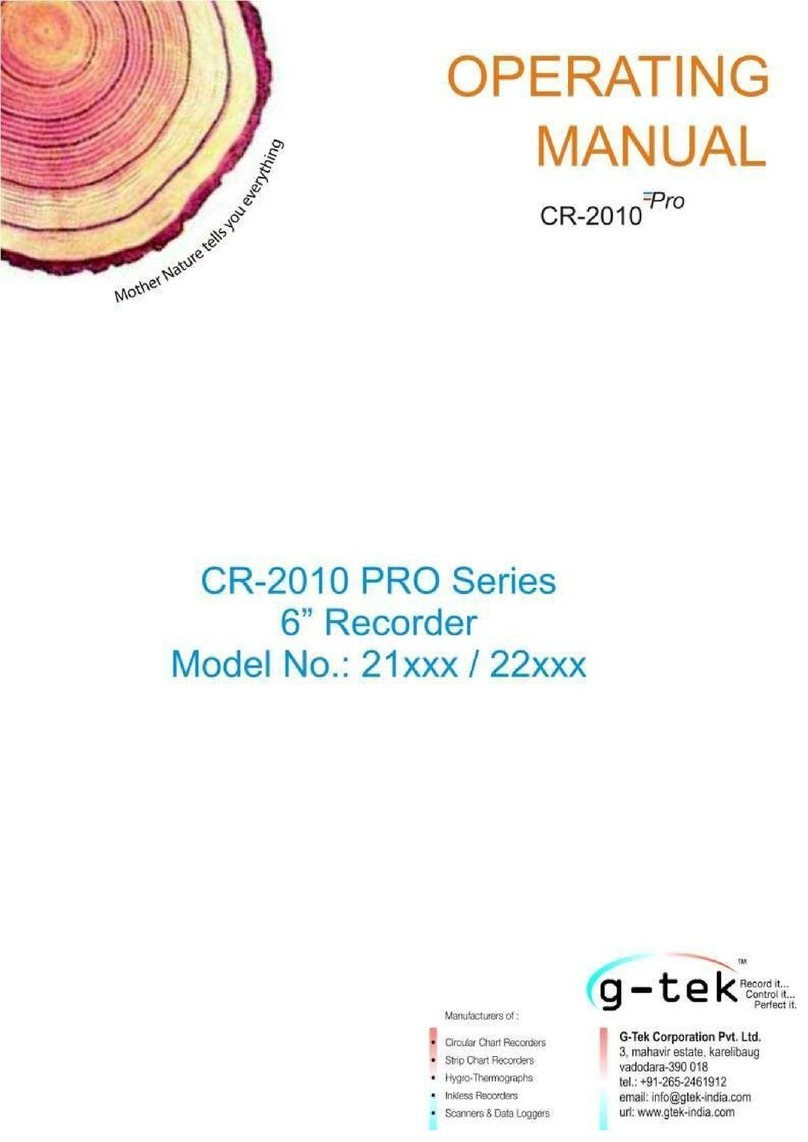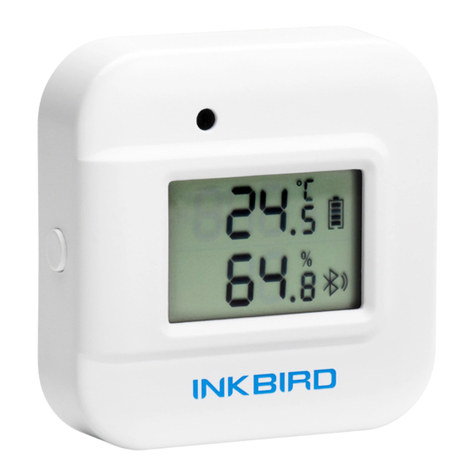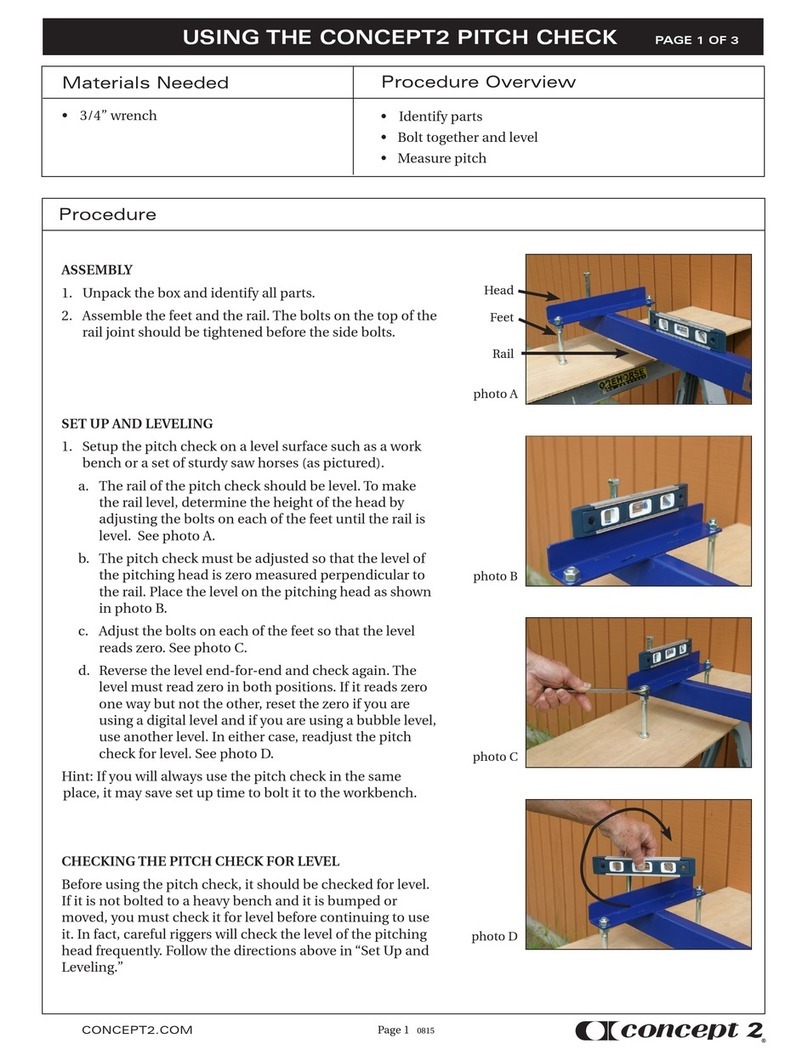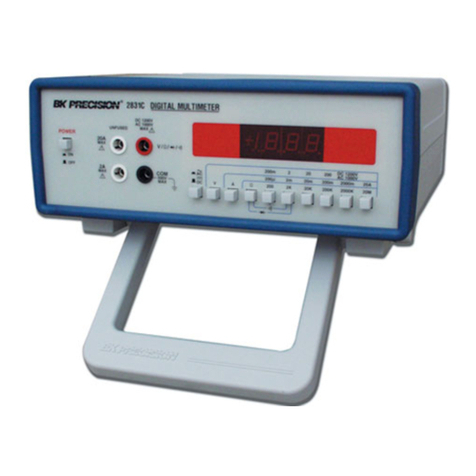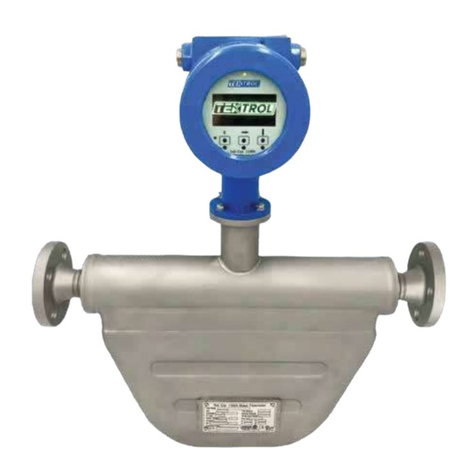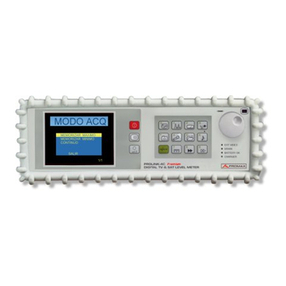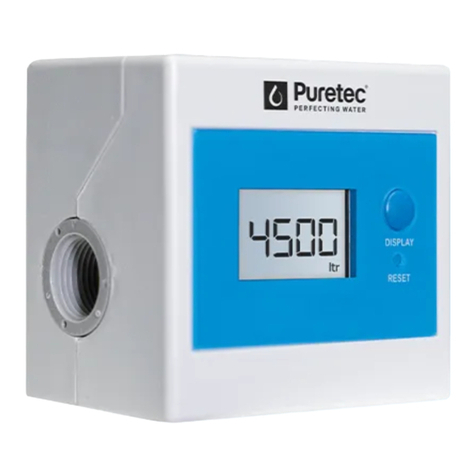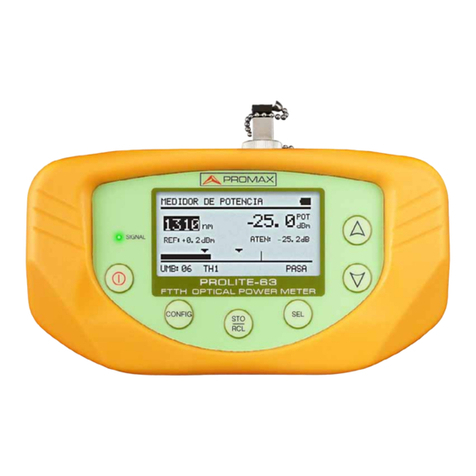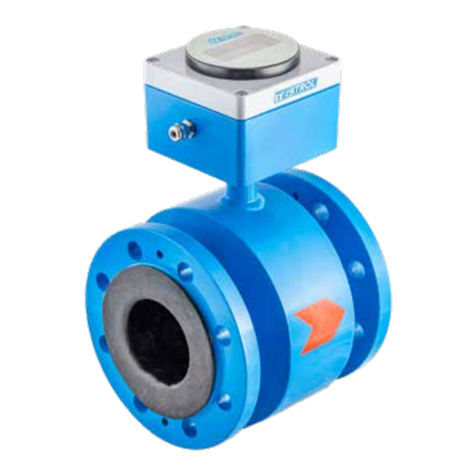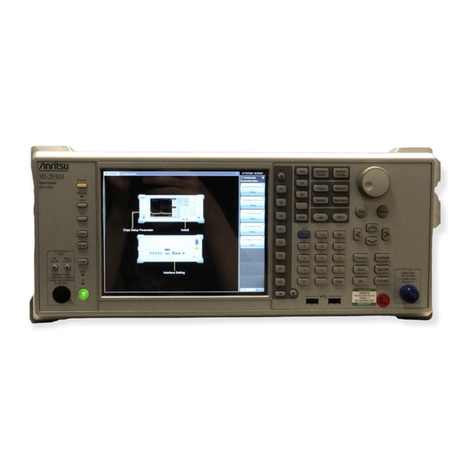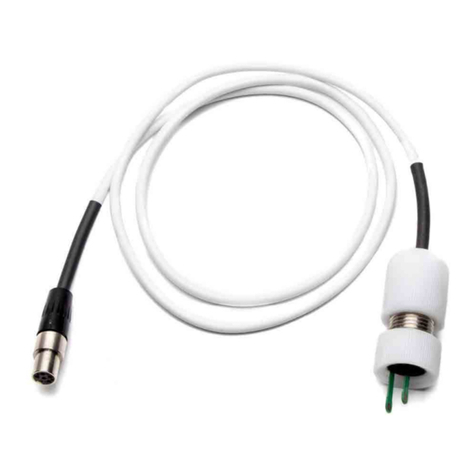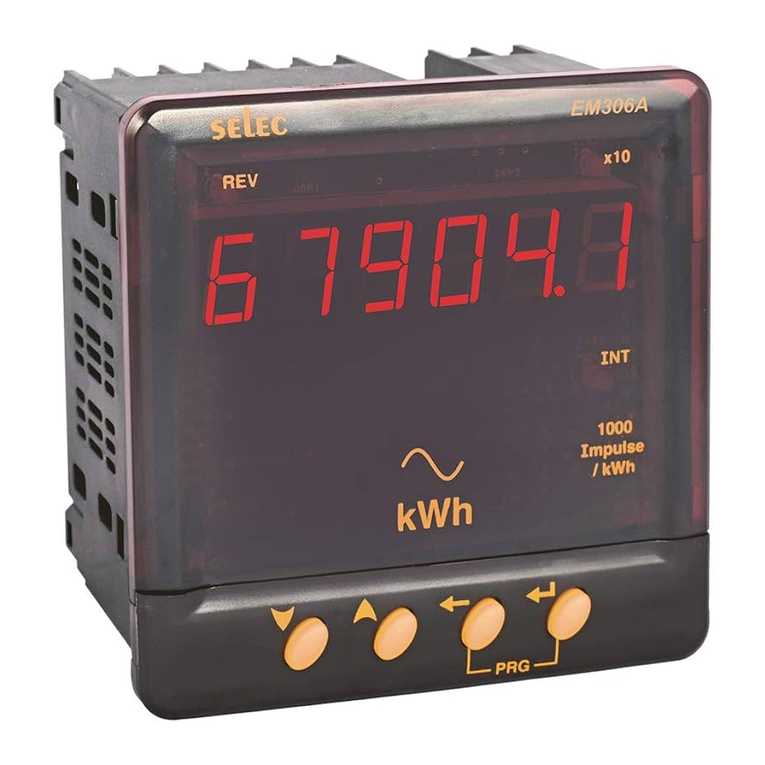BOREAL LASER GasFinderMC-2 User manual

GasFinderMC
BOREAL LASER INC.
Operation Manual
MULTI-CHANNEL SYSTEM
This Manual applies to:
GasFinderMC-2
GasFinderMC-4
GasFinderMC-8
Boreal Laser Inc GasFinderMC Operation Manual July 17th 2017
Menu ver. mv1.10e Part no. NDC-200010-F
12846 146 Street NW • Edmonton, Alberta • CANADA • T5L 2H7
Phone: +1 780 488 5173 • Fax: +1 780 488 0780 • www.boreal-laser.com

ii
Boreal Laser Inc. GasFinderMC Operation Manual — Contents July 17th 2017
Rev. 1 January 2005 All
Rev. 2 November 2006 Menu
Rev. 3 January 2007 Menu
Rev. 4 October 2010 Menu
Rev. 5 January 2011 Menu
NDC-200010 August 2011 All (ver. MV1.06.c)
NDC-200010-A October 2011 Certification (ver. MV1.06.c)
NDC-200010-B January 2012 Title Pages (ver. MV1.06.c)
NDC-200010-C December 2012 All (ver. mv1,10.e)
NDC-200010-E May 2013 All (ver. mv1,10.e)
NDC-200010-F July 17th 2017 Laser specs (ver. mv1,10.e)
BOREAL LASER INC.
Publications by Boreal Laser Inc.
Operation Manuals:
GasFinder2 NDC-200023-B
GasFinderFC NDC-200004-B
GasFinderFCr NDC-200005-B
GasFinderAB NDC-200006-A
GasFinderMC NDC-200010-E
GasFinderPT NDC-200021-B
GasFinder2 for
Multiple Path Monitoring NDC-200025-A
User Manuals:
GasViewOP NDC-200022-C
GasViewMC NDC-200013-B
GasMap NDC-200007-A
Accessory Manuals:
4-20mA Module NDC-200014-A
RF Barrier Module NDC-200027-A
DCR Module NDC-200016-A
Diagnostic and
Troubleshooting Kit NDC-200026
Copyright 2013 Boreal Laser Inc. All rights reserved.
Reproduction in any manner without the written permission of Boreal Laser Inc. is strictly forbidden.
Boreal Laser Inc. makes no representations or warranties with respect to the contents of this document.
Boreal Laser Inc. assumes no responsibility for errors or omissions or any damages resulting from the use of the
information contained in this document. Information in this document is subject to change without notice.
Ph.+1 780 488 5173 Fax +1 780 488 0780
E-mail <support@boreal-laser.com>

iii
Boreal Laser Inc. GasFinderMC Operation Manual — Contents July 17th 2017
Before operating the system, please read this manual fully to obtain the best results from
your product. The lightning flash with arrowhead inside the triangle, is intended to alert the
user to the presence of un-insulated dangerous voltage within the products enclosure that
may be of sufficient magnitude to constitute a risk of electrical shock to persons.
CAUTION:TOPREVENTTHERISKOFELECTRICSHOCK,DONOTREMOVECOVER(OR
BACK). NO USER-SERVICEABLE PARTS INSIDE. REFER SERVICING TO QUALIFIED
SERVICE PERSONNEL ONLY.
SAFETY INSTRUCTION:
Please read all the instructions herein.
Please heed all safety warnings. Please retain this manual for future reference.
Please install in accordance with these instructions.
WARNING
TO REDUCE THE RISK OF ELECTRIC SHOCK:
Do not expose this equipment to rain or moisture.•
Do not use the unit near water, and do not immerse in any liquid or pour any liquid on the unit.•
Servicing is required when the unit has been damaged in any way, such as the power-• supply cord or plug is damaged, liquid has been spilled or objects have fallen into the unit,
the unit has been exposed to rain or moisture, does not operate normally, or has been
dropped.
Refer all servicing to qualified personnel only. The equipment contains no user servicable parts.•
Note that if the equipment is used in a manner not specified in the manual,
the protection provided by the equipment may be impaired.
Removal of the equipment cover will void any warranty.
Disclaimer
Boreal Laser Inc. assumes no liability or responsibility for issues or harm resulting from the
use of this equipment.

iv
Boreal Laser Inc. GasFinderMC Operation Manual — Contents July 17th 2017
BOREAL LASER INC.
BOREAL LASER INC.
GasFinderMC
Contents
Section 1. System Description........................................................................................1.1
Specifications............................................................................................................... 1.3
GasFinderMC ............................................................................................................................. 1.3
Remote Heads............................................................................................................................ 1.3
Duct Probe.................................................................................................................................. 1.3
Duct Probe Retro........................................................................................................................ 1.3
Certification.................................................................................................................. 1.4
Accessory Modules...................................................................................................... 1.4
Labels .......................................................................................................................... 1.4
Safety Concerns .......................................................................................................... 1.4
Section 2. Pre-Installation Checks..................................................................................2.1
Tools and Equipment.................................................................................................................. 2.2
Section 3. Installation....................................................................................................... 3.1
GasFinderMC............................................................................................................... 3.1
Retroreflectors ............................................................................................................. 3.2
Transceivers (Remote Heads, Heads).........................................................................3.4
OP1 Short Path Transceiver Head ............................................................................................. 3.4
OP3 Long Path Transceiver Head.............................................................................................. 3.5
Optical alignment........................................................................................................................ 3.7
Adjusting the Aiming Scope........................................................................................................ 3.8
OP4 Long Path Transceiver Head.............................................................................................. 3.9
Duct Probe.................................................................................................................................3.11
Attenuation.................................................................................................................................3.11
Cable connections ..................................................................................................... 3.12
Fibreoptic..................................................................................................................................3.12
Coaxial...................................................................................................................................... 3.13
Data.......................................................................................................................................... 3.14
Power........................................................................................................................................ 3.14
Accessory Modules.................................................................................................... 3.15
Section 4. Data Input/Output........................................................................................... 4.1
DB15 Connector .......................................................................................................... 4.1
Serial Communications................................................................................................ 4.2
Data String Specification ............................................................................................................ 4.2
Downloading Data........................................................................................................ 4.5
Section 5. Operating Instructions................................................................................... 5.1
Start Up........................................................................................................................ 5.1
Menu Details................................................................................................................ 5.3
Channel-Specific Menus............................................................................................................. 5.3
System Menus............................................................................................................................ 5.5
Operation Manual

v
Boreal Laser Inc. GasFinderMC Operation Manual — Contents July 17th 2017
Section 6. Maintenance.................................................................................................... 6.1
GasFinderMC............................................................................................................... 6.1
Remote Heads and Probes.......................................................................................... 6.1
Cables.......................................................................................................................... 6.1
Retroreflectors. ............................................................................................................ 6.2
Routine System Check and Preventive Maintenance.................................................. 6.3
Accessory Module Maintenance..................................................................................6.5
Section 7. Troubleshooting ............................................................................................. 7.1
Array Transfers ............................................................................................................ 7.4
Stability of Support Structures ..................................................................................... 7.5
Types of Supports........................................................................................................ 7.6
Alignment Procedures for a Moving Building...............................................................7.7
Centering the Cross Hairs............................................................................................ 7.8
Section 8. The Basics of Laser Gas Detection .............................................................. 8.1
Tuneable Diode Laser..................................................................................................8.1
Absorption Lines ......................................................................................................... 8.1
Gas Detection with a Laser..........................................................................................8.2
Retroreflectors ............................................................................................................. 8.3
Glossary of Common Terms and Abbreviations...........................................................8.4
Section 9. Appendices ..................................................................................................... 9.1
Appendix A — Menu ................................................................................................... 9.1
Appendix B — Status Codes ....................................................................................... 9.3
Appendix C — Explanation of ppmm...........................................................................9.4
Appendix D — Explanation of R2 ................................................................................ 9.5
Appendix E — Conversion from ppm to mg/m3........................................................... 9.7
Appendix F — 2-Way Serial Communication...............................................................9.8
Appendix G — Calibration ........................................................................................... 9.9
Appendix H — Pre-Ship Settings...............................................................................9.10
Appendix I — Accessories.........................................................................................9.11
Appendix J — Cable Compensation..........................................................................9.12
Section 10. Drawings ..................................................................................................... 10.1
1. JB 0723 MC-A MC Interconnection Diagram
2. JB 0125 MC-A MC Instrument Overall Dimensions
3. BOR 02110-J OP1 Head Overall Dimensions
4. JB 0930 RH-B OP3 Remote Head Dimensions
5. DM OP6 OP6 Conceptual Drawing Dimensions
6. DP-D-V1-0001 V1 Duct Probe General
7. DP-D-V1-0002 V1 Duct Probe Dimensions
8. DP-D-V1-0003 V1 Duct Probe PurgeAir Connections
9. PK 1023 UE-A Rev.D Remote Head Enclosure Baseplate
10. BOR 0210 OP3 SS Enclosure Dimensions
11. BOR 2915 OP3 SS Tilting Joint Dimensions

vi
Boreal Laser Inc. GasFinderMC Operation Manual — Contents July 17th 2017
GasviewMC Software Display
OP1 Open Path Transceiver Head
V1 Duct Transceiver (Probe)
OP3 Open Path Transceiver Head
OP4 Open Path Transceiver Head

vii
Boreal Laser Inc. GasFinderMC Operation Manual — Contents July 17th 2017
Product Warranty
Boreal Laser Inc. provides a standard warranty with the GasFinderMC. The warranty covers
the GasFinderMC instrument plus spare parts ordered through Boreal Laser Inc.
For items covered by the standard warranty, Boreal Laser Inc. guarantees that during the
first 12 months following delivery, there will be no charges for parts or service required to
correct:
Equipment breakdowns•
Equipment malfunctioning•
Repeated or recurring faults or errors in the system.•
Instrument shipping and/or travel expenses for on-site service will be charged at cost.
Thiswarrantydoesnotapplytosituationswheresystemperformancehasbeencompromised
as a result of customer negligence or abuse or damage resulting from natural disasters.
Boreal Laser Inc. provides software upgrades and unlimited telephone and e-mail support
free of charge for the lifetime of the installation.
Extended warranty is available, see your Boreal Laser Inc. sales contact for information.
Procedure for returning the GasFinderMC
If the unit has to be returned for service or repair, please contact Boreal Laser Inc. for a return
material authorization (RMA) number and form. An email will be sent containing complete
instructions on how to package the unit and containing a shipping address.
Tel: +1 780 488 5173
Fax: +1 780 488 0780
Email:support@boreal-laser.com

viii
Boreal Laser Inc. GasFinderMC Operation Manual — Contents July 17th 2017

2.1
Boreal Laser Inc. GasFinderMC Operation Manual— Pre-Installation July 17th 2017
Section 2. Pre-Installation Checks
GasFinderMC
A site survey should be undertaken to check the following points:
Temperature Limits:• theGasFinderMC cabinet should belocated
in a temperature regulated (100C to 300C) room in an area which
minimises the length of cable runs (limit the length to 750m). A
compromise for the location usually has to be found, but if no
suitable room is available, an air-conditioned cabinet can be used.
• Power Supply: 110/220V 3Apowershouldbe availableinthe cabinet withspare110Voutlets
if possible. A UPS may be desirable.
• Accessibility: safe access to the front and rear of the GasFinderMC should be possible
with a hinged cabinet mount.
• Size: the cabinet should be big enough to accommodate all the required modules and splice
boxes and cable terminations.
• Cables: cable trays or conduit should be used to support the coaxial and fibreoptic cables
between the GasFinderMC and the Remote Heads or Duct Probes. Do not run cables
alongside power cables, especially cables used for Variable Frequency Drives.
Retroreflectors
Retroreflector locations should be chosen to limit paths to the suitability of
the remote head and be in areas that are safely accessible for cleaning when
necessary. Dusty locations should be avoided if possible. Steam may pose a
problem if it is dense and consistently crosses the path.
If the location is outside and the climate is humid, a rain hood and a heated
enclosure may be necessary to prevent condensation on the window. This
usually requires an outlet close by to supply power to a heater.
The reflector mounting can tolerate small vibrations and movement, but the reflector enclosure
should be attached with the front window perpendicular to the path. There should be no
obstructions in the path between the retroreflector and the head.
Remote Heads
Remote Head locations should be chosen with regard to visibility and
limiting paths to 500m for OP3 Remote Heads, 1km for OP4 Remote
Heads and cable runs to 750m or an appropriate distance to pull the
cable, and be in areas that are safely accessible for installation and
maintenance. Dusty locations are to be avoided if possible. The Remote
Head mounting can withstand small vibrations and some translational
motion but is extremely sensitive to rotational movement. The mounting
must be rigid and well braced. Pre-terminated cables can be brought
directly into the enclosure, otherwise it is necessary to use a splice
box close (1m) to one side and run a patch cord to the Remote Head.
Mounting locations outside where sun can strike directly on the mount
structure may require insulation to prevent movement due to differential heating.
Cabinet, CCU &
4-20mA Module
Remote Head
2 stainless steel enclosures
with remote heads
Heater

2.2
Boreal Laser Inc. GasFinderMC Operation Manual— Pre-Installation July 17th 2017
Duct Probes
Alignment is made easier if the flanges for the Duct Probes are
welded perpendicular to the path axis. Clean air up to 10 litres/
min, controlled with a regulator, should be provided for purging
the Duct Probe and retro windows. Ducts with a heavy dust load,
may require a higher flow rate.
Tools
Required:
Site-specific personal protective equipment• Permanent marker or pen• Set of assorted cable ties• Nylon spiral wrap• Socket wrench set• Small adjustable “crescent” wrench• Small vise grips• Small file• Phillips, Robertson and Flat Head screwdrivers• Allen Keys (imperial and metric)• Coaxial-cable termination tool• (Amphenol crimper:ARF1118 with CTL-3 jaws. 0.100D and 0.429D.)
Wire cutters, wire stripper, linesman’s scissors, pliers• Knife• Duct tape• Electrical tape and self-amalgamating tape• Label maker or cable markers• Silicone sealant RTV3145• Twist drill set and step-bit or hole-saw selection• Small multimeter• Diagnostic and Troubleshooting Kit• Ladder and/or man-lift (as appropriate)• If pre-terminated cables are not used then a cable splicer is required capable of making•
FC/APC connections.
Optional/Recommended:
Tap set• Portable drill• Bungee cords (assorted sizes)• Two-way radios (if permitted)•
Equipment Check
Verify that all the equipment on the order sheet has
arrived complete and in good condition. Any damage
due to shipping should be reported immediately and
steps taken to obtain replacement parts.
Order ready for shipment
2 Duct Probes with Purge
Air and Splice Box

3.1
Boreal Laser Inc. GasFinderMC Operation Manual— Installation July 17th 2017
Section 3. Installation
GasFinderMC - CCU
The GasFinderMC CCU fits into a standard 19” (485mm) wide rack and is 3U (132mm) high.
Small rubber feet on the bottom of the unit increase the height to 140mm. These feet can
easily be removed if space is limited, although this is not recommended as it restricts airflow
for cooling.
If the rack is mounted to a wall or access to the rear is difficult, a hinged rack mount is
required. This allows the CCU to swing outwards and makes the cable connections, which
are all at the rear, much easier to install. The cables should be routed on the hinged side of
the cabinet in order to minimise their movement.
Accessory modules are available for 4-20mA output, RF Barrier protection and Dry Contact
Relay output. These modules are described in their own manuals.
A schematic illustrating the cable connections is shown in the drawing section at the rear of the
manual.
Caution: The infrared laser output from the GasFinderMC has very low
power (conforms to Class 1 as per IEC 60825-1) and will not damage
eye tissue.
However, it is the recommendation of Boreal Laser Inc. that, as with
ANY LASER SYSTEM, the user/ operator should avoid staring directly
into the output aperture of the instrument.
Note that the laser beam is infra-red and is not visible to the eye.
Safety Issues.
Tools Required: electrician’s hand tools.
The Boreal Laser Diagnostic and Troubleshooting Kit for MC Systems is recommended.
Cabinet, front view Cabinet, rear view
CCU
4-20mA Module
Relay Module
Sequence of the Installation: the preferred sequence is to install the Central Control Unit
(CCU) and the retroreflectors first and then the Remote Heads. This ensures that when the
Remote Heads are installed they can be aligned at the same time.

3.2
Boreal Laser Inc. GasFinderMC Operation Manual— Installation July 17th 2017
Reflector
Types Path
Length
Array of up to 76
63mm Retros 600m–750m
Description
Grey Tape comes in sheets 200mm x 300mm. It
is adhesive backed and can easily be attached to
any smooth, dry surface. It is often stuck to the
back of a retro enclosure.
Grey Tape 5m--40m
The tape comes in rolls 16m x 50mm wide. The tape is
dividedintoredandsilverbandsandeachhavedifferent
reflective properties. The tape is adhesive backed and
can easily be attached to any smooth, dry surface. It is
often stuck to the back or side of a retro enclosure.
Red/White
Tape 1m--5m
These are multi-faceted IMOS 46mm hexagons.
They can be fitted together to make up a large
composite array.
IMOS Plastic
46mm Retro 30m--100m
The IMOS array shown is made from 14 single
hexagonal Retros. They are normaly mounted
on a back plate which is placed in a stainless
steel or FRP enclosure.
IMOS Array 50m-- 300m
76 Retros are probably the maximum
number that can be economically used as
the cost becomes prohibitive as the number
of Retros increases. At path lengths greater
than750m,maintainingthecorrectalignment
becomes difficult.
These Retros are enclosed in a PVC, RPF
or stainless steel enclosure. The number of
Retros will depend on the type of gas being
measured, the path length and atmospheric
conditions. The window is normally Lexan
but can be changed to a special glass when
measuring some gases. For use outside,
rain hoods and heated enclosures are
recommended to prevent condensation.
Array of up to 6
63mm Retros 75m – 400m
This is a gold plated hexagonal Retro. It is normally
housedin aplastic or steel box witha Lexan
window. They can also be fitted together to
make up a large composite array.
Gold Plated
63mm Retro 75m--150m
The enclosures will vary in size depending on the number of retroreflectors and if internal
heating is required. Window materials will depend on the site conditions and the gas to be
measured. Lexan is normally supplied but window glass, boro-silicate and sapphire are
used under specific circumstances. Contact Boreal Laser Inc. for more information.

3.3
Boreal Laser Inc. GasFinderMC Operation Manual— Installation July 17th 2017
Retroreflectors (Retros)
The Retro is a vital part of the system and choosing the correct type is necessary for the correct
operation of the system. Refer to page 3.2 for details on choosing a retro. For short paths where
reflective tape is used, the tape can be attached to the back of an enclosure which is fitted to a
tripod or placed on a wall in any convenient location. The angle of the tape can be adjusted to
give an adequate signal return provided this does not degrade the R2value.
Where Retros are used on longer paths, these may be mounted in an enclosure on a• tripod, or the enclosure placed in any convenient location.
Purge air may be required for Retros used in ducts.•
Where long paths are measured in metal buildings, the Remote Head may go out of• alignment as a result of solar heating deforming the structure. The preferred solution is
to use multiple Retros. See page 7.7
The• GasFinderMC does not require any changes when different path lengths are
measured unless ppm values are needed, in which case the distance must be set and an
appropriate Retro used.
Light Values
The type of Retro used will depend on the path length, atmospheric conditions such as dust or
fog, the type of head and the type of laser. When choosing a Retro, the prime concern should
be to keep the returning light level value between the preferred values of 4,000 and 8,000.
The range of the value is between 1000 and 16,368. Below 1000 the display will indicate “Low
Light”. There is no indication that the returning light has exceeded 16,368. When this happens
the receiver saturates and the displayed light value could read very low (<200). In this situation
the gas concentration readings will be in error and it is also possible to cause damage to the
optical components. The light value can be adjusted with the use of different Retros.
Note: Care should be taken to ensure that the returning light does not exceed 14,000.
Condensation
Condensationonthesurfaceofthewindowiscausedbythewindowtemperature
falling below the dew point. This may occur in areas of high humidity or large
temperature differences between day and night. The enclosures are well
sealed but condensation can sometimes occur on the inside of the window.
Condensation can usually be controlled by the following measures:
Fastenacoverorrainhood over the enclosure toshieldthewindowfromradiationcoolingatnight.• This also prevents rain from striking the window.
Use a desiccant pack inside the enclosure. This will only prevent• condensation on the inside.
Place a heater in the enclosure. The heater can be 12W to 50W• depending on the size of the enclosure and the conditions of operation
andiscontrolledbyathermostattopreventoverheating.Theheaterraises
the temperature of the enclosure and prevents condensation forming
either on the inside or the outside of the window. To minimise heat loss
the enclosure is insulated. This option requires power to be supplied and
there are heaters available for use in hazardous areas.
Two Enclosures with
Heaters and Rain Hoods
Radiation Shield
4 Retros
4 Retros
Heater
Heater
Thermostat
Thermostat
4 Retros and Heater in
insulated Enclosure

3.4
Boreal Laser Inc. GasFinderMC Operation Manual— Installation July 17th 2017
Transceivers (Remote Heads, Duct Probes)
There are 4 types of transceivers to which the GasFinderMC can be connected:
- OP1
- OP3
- V1
OP1 Open Path Transceiver (Remote Head)
This Remote Head is designed to be used for path lengths up to 50m. It has a weather
resistant stainless steel assembly and has an adjustable base. It is
fastend with a single 12mm bolt and locking screws if required.
Mount the Remote Head directly to a galvanised steel plate• at least 100mm square. Rotate the unit so that the head is
aligned with the reflector. Tighten the 12mm bolt.
Remove the 8 screws from the rear plate.•
Connect a visible laser to the fibreoptic laser connector at the• rear of the unit.Align the Remote Head until the red dot
appears on the reflector.
Connect the fibreoptic and coaxial cables to the rear• connectors and to the GasFinderMC and switch on.
Make a final alignment adjustment by maximising the light• return value. Tighten all the locking screws and secure the
cables, making sure that the weight of the cables does not
alter the alignment of the Remote Head.
OP1 Head
2 OP1 Heads
Reflector for a 100mm path
8 fastening screws
Co-ax connector
Laser connector
Horizontal
alignment screw
Vertical
alignment screw

3.5
Boreal Laser Inc. GasFinderMC Operation Manual— Installation July 17th 2017
OP3 Open Path Transceiver (Remote Head)
This Remote Head is designed to be used for path lengths up to 750m. It can be fitted in an
enclosure and uses an X-Y mount and scope for alignment. It can also be used mounted on
a tripod for portable use.
X-Y Mount
Red Aiming
Laser Input
I.R. Laser Input
Aiming Scope
Vertical Locking
Screws
Cross Hair Adjustment
Screw Covers
Horizontal
Locking Screws
Vertical
Alignment Screw
1 turn - 2.0 mrad
Coaxial Output
Horizontal
Alignment Screw
1 turn - 2.6 mrad
Installing the Mount and the Stainless Steel Enclosure
Caution. care should be taken not to get the fingers trapped between the cover and the
sides of the base, especially before the shocks have been connected.
Remove the enclosure from the packing case, open the cover• and remove the base and the nose from inside.
There is a tubular spring loaded support laying at either side of the• base. Remove the plastic bag and attach the front of the support to
the front of the cover.
Nose
Base
Top
cover
Support

3.6
Boreal Laser Inc. GasFinderMC Operation Manual— Installation July 17th 2017
Attach the nose to the front of the base by inserting the tabs on the•
nose into the slots and twisting the tabs on the inside.
Remove the two locking screws for the bottom plate• of the XY mount and raise the top two plates.Use the
two 8 x 32 x 3/4” screws to fasten the remote head to
the mount.
Use the four ¼” x 20 x• 1/2” screws to fasten the X-Y mount to the
stainless steel bottom plate.
Bolt the base mount to a structurally stable base (see• page 7.5),
and bolt the stainless steel enclosure with the Remote Head to
the base mount. Use the base mount to align it approximately with
the retro.
If the aiming scope is not already attached, fasten it to the Remote• Head with the large end towards the operator.
Tabs
Nose
Front of enclosure
Assembled enclosure
Base mount
Four ¼” x 20 x 1/2” screws
Two assembled enclosures mounted on a column
Two screws
8 x 32 x 3/4”

3.7
Boreal Laser Inc. GasFinderMC Operation Manual— Installation July 17th 2017
Optical alignment
Once the Remote Head is fastened, adjust the two alignment screws on the X-Y mount so
that the Retro appears in the centre of the cross hairs in the alignment scope.
Verify that the entire Retro is clearly visible and there are no obstructions in the path.
Ensure that the GasFinderMC is enabled and locked to the
channel being adjusted. Connect the Remote Light Meter
(RLM) to the coaxial fitting on the rear of the head. Adjust the
X-Y mount with the horizontal and vertical adjustment screws
so that the reading on the RLM is as high as possible. Gently
tighten the 4 red locking screws on the mount, ensuring that
the reading on the RLM does not decrease. Note that the RLM
will read about 1/10 the value shown at the GasFinderMC.
A reading below 200 is an indication that more reflectors are
required on that path.
A reading greater than 2000 is an indication that the laser
signal may have to be attenuated.
If the retroreflector is not visible in the alignment scope or
difficulty is experienced getting a reading on the RLM, connect
thevisiblelasertothefibreconnectorlocatedabovethecoaxial
connector. Switch on the visible laser. Using the continuous
redbeamnowbeingemittedfromtheRemoteHead,themount
can be adjusted so that the red beam is reflected back from
the retroreflector.As soon as the RLM registers a reading, the
visible laser use can be discontinued and the RLM used for
precise alignment.
Note: the reflected beam of the visible laser is very bright
and should not be observed through the aiming scope.
The iaiming laser output from the Visible Laser has very low power (conforms to Class
1 as per IEC 60825-1) and will not damage eye tissue.
Remote Light Meter
Visible Laser and
Remote Light Meter

3.8
Boreal Laser Inc. GasFinderMC Operation Manual— Installation July 17th 2017
Adjusting the Aiming Scope
Cross Hairs
If the cross hairs on the scope do not line up with the
centre of the retroreflector, they can be adjusted by
unscrewing the covering caps in the centre of the scope
and adjusting the rectangular-headed screws underneath.
The factory setting is made so that the cross hairs converge with the laser beam at 100m.
Due to the vertical displacement of the scope, the cross hairs will appear above the beam at
distances below 100m.
It is better to start by adjusting the mount for maximum signal by maximising the light value
reading and then centre the cross hairs in the centre of the Retros by adjusting the cross
hairs with the scope adjustment screws. Note that the scope is made for a rifle where the eye
is always at a fixed position determined by the stock at a set distance behind the scope. If
you are not at the correct distance from the eye-piece, moving the eye laterally will cause the
cross hairs to move across the Retro.
Remove the caps covering the adjustment screws.•
Turn the zoom on the scope to a maximum.•
Focus the eye-piece so the retros are sharp.•
Position your eye so that all the apertures in the scope are• concentric and open the full diameter.
Depending on your eyes, this may be about 6 inches away from the eye-piece. Then the• cross hairs intersect on the centre line and will not move laterally.
Turn the horizontal and vertical screws as necessary to position the cross hairs in the• centre of the retro.
Replace the covers.•
Focus and Zoom
The two adjustable rings at the front of the scope can be turned to
adjust the focus and zoom. When cold these rings are extremely stiff.
The zoom is used at a minimum when locating the Retro and at a
maximum when checking for movement and aligning the cross hairs.
Focus the eye-piece so the Retros are sharp.
When all adjustments to the scope are finished, tighten all the locking
screws.
Note: Make sure that these adjustments do not mis-align the system.
Covering
Cap
Vertical
Adjustment
Horizontal
Adjustment
Focus
Ring
Zoom Ring
Cross Hair Adjustments
Focus
Zoom
Aiming Scope

3.9
Boreal Laser Inc. GasFinderMC Operation Manual— Installation July 17th 2017
V1 DUCT Transceiver (Duct Probe)
TheDuctProbeisdesignedforuseacrossductsandstacksand
consists of a laser emitter and receiver in one unit. The laser
beam is targeted on a retroreflector at the opposite side of the
duct or stack. In some instances of high gas concentration, the
Retro can be replaced by a receiver for single pass operation.
The type of retroreflector usually depends on the particulate
loading in the duct and can vary from grey tape to a 62mm
retroreflector.
Mounting
Each Duct Probe mounts to a 150 lbs, 3” ANSI flange.
It is important that if the flanges are welded orthogonally to the duct, then both Duct Probe
and retro flanges should be mounted at the same height.
Purge air
Purge air at 1 to 5 l/m will usually prevent dust from settling on the reflector or the window
inside the Duct Probe.
Heating
If the Duct Probes are subjected to a temperature lower than that in the ducts they may have
to be insulated and heated to prevent condensation forming on the window or the Retro.
Optical Alignment
Remove the opposite port cover plate.
Attach a visible laser to the optical connector in the Duct Probe and
adjust the alignment screws so that the red beam is visible in the
opposite port. Most ducts have a particulate load and the red laser
can easily be seen reflecting off the particles.Apiece of white paper
placed over the port can assist in centering the beam.
Place the retroreflector in the port and connect a Remote Light Meter
(RLM) to the coaxial connector. Remove the Visible Light Meter and
connect the fibreoptic cable from the GasFinderMC to the Duct
Probe. Energise the channel to the Duct Probe.Adjust the alignment
screws to obtain maximum signal on the Remote Light Meter. The
signal may require attenuating so that proper alignment is possible.
Connect the coaxial cable between the GasFinderMC and the Duct Probe.
Attenuation
Because of short path lengths it is often necessary to lower the signal
strength.Thisisdonebyusingavariablefibreattenuatorwhichbendsthe
fibre. The light level should not exceed 14,000 at the GasFinderMC.
V1 Duct Probe
Variable Fibre Attenuator
2 Duct Probes with purge air 2 Duct Retros with purge air
Alignment Screws
Pivot Point

3.10
Boreal Laser Inc. GasFinderMC Operation Manual— Installation July 17th 2017
Cable connections
Fibreoptic Cables
Caution:the laser output from the control unit has a very low power and will not damage
eye tissue. It conforms to Class 1 as per IEC 60825-1. However, as with all laser
instruments, it is prudent to avoid looking directly into the laser beam. Note that the laser
beam is infra-red and is not visible to the eye.
Tools Required: Electrician’s hand tools. The Boreal Laser Inc. Diagnostic and
Troubleshooting Kit for MC Systems (BL-KDT2) is recommended.
Cleanliness
It is of paramount importance when dealing with fibre optic cables
that clean work practices are followed. The core of a single mode
optical fibre is 9 microns in diameter, and a speck of dust can
easily block the signal. It is important to clean the connectors
before inserting them into the couplings. This is done by holding
the end of the connector perpendicular to a clean section of tape
and describing a figure of eight movement two or three times. The
cleaning tape is held in a dispenser which exposes a new section
of tape as needed. Do not use alcohol as it leaves a residue.
Dignostic and Troubleshooting Kit
The Diagnostic and Troubleshooting Kit contains a Remote Light
Meter (RLM), Power Meter, Visible Laser, Infra Red (IR) card,
cables and cleaning tape.
Fibreoptic Connections
The fibreoptic couplings are FC/APC and are used to
connect two FC/APC fibre connectors. There is a key
on the connector barrel to align with the keyway in the
coupling. The key and keyway must be engaged in order
for the connection to be made correctly.
Cables
The laser output from the GasFinderMC is taken from the FC/APC
connector on the rear panel of the instrument. The connection to
the Remote Head or Duct Probe is made with a single mode fibre-
optic cable which may be a single fibre or a dual fibre, in which one
is used as a spare, or via a multi-fibre cable and a splice box.
The fibres can be purchased with the ends pre-terminated or a
multi-fibre cable can be spliced to a pre-terminated ‘pig tail’ on site
by a contractor who specialises in fibre-optic FC/APC cable splicing.
Special care is required when installing the cables as too much strain will break them or
cause large losses. Cable tray is easier to work with than conduit. Cable ties should be firm
but not tight.Any bending should be limited to a 30mm radius. Nylon Spiwrap cable protector
is very useful for supporting cable and preventing sharp bends.
Cleaning connectors
Diagnostic and
Troubleshooting Kit
Coupling & Connectors
Keyways
Key Key
Splice Box
This manual suits for next models
2
Table of contents
Other BOREAL LASER Measuring Instrument manuals
